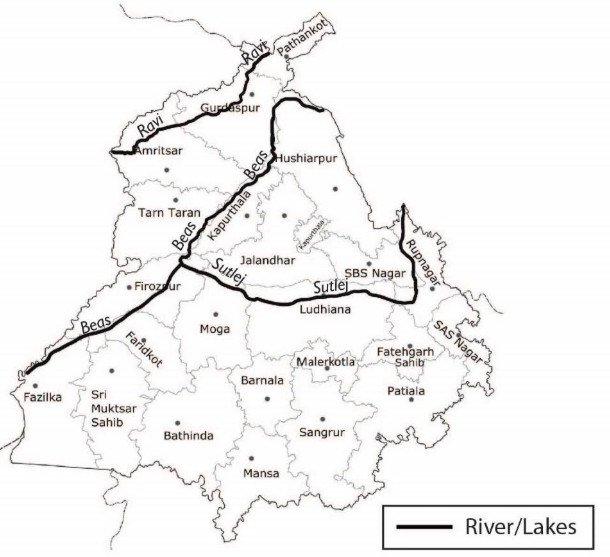In the turbulent days leading up to India’s independence in 1947, when the partition lines were being drawn, there were many forces at play that would shape the future of the newly formed nations. Amidst this chaos, three unsung heroes—Indian civil engineers—played a pivotal role in ensuring that India retained control over the vital waters of Punjab, a decision that would have far-reaching consequences for the region’s survival and prosperity. Their quiet yet crucial intervention helped India secure control over the Ferozepur Headworks, a key infrastructure point that would later become a central issue in the formation of the Indus Water Treaty. These engineers, motivated purely by patriotism, did what many failed to comprehend during the partition: they understood the engineering complexities that could alter the course of history.
As the Radcliffe Line was being drawn to separate India and Pakistan, the fate of Punjab’s rivers—particularly those passing through the critical Ferozepur Headworks—was up in the air. Ferozepur, a town in Punjab, was dangerously close to being included in Pakistan’s territory. For India, losing control of the Ferozepur Headworks would mean losing control over three major canals that were crucial for water distribution in both Punjab and Rajasthan. In fact, these canals even fed into the Gang Canal of Bikaner, an important lifeline for that region.
Among the engineers who recognized the gravity of this situation were A.N. Khosla, Sarup Singh, and Kanwar Sen. At the time, Khosla and Sarup Singh were stationed in the Punjab irrigation department, while Kanwar Sen was working with the water department in the Bikaner state. As engineers, they had an in-depth understanding of the hydraulic systems and the geopolitical significance of Ferozepur. When they realized that Ferozepur was marked to go to Pakistan, they recognized the profound implications this would have for India’s control over water resources in the region.
Sarup Singh, deeply concerned by the potential loss of these crucial waterworks, decided to take action. He secretly communicated with Kanwar Sen in Bikaner, warning him about the impending division of Ferozepur. Kanwar Sen, equally astute and aware of the consequences, understood the urgency of the matter. He immediately took the issue to Pannikar, the Prime Minister of Bikaner, explaining the critical situation. They decided to approach the Maharaja of Bikaner, Sadul Singh, a man who had personal connections with Lord Mountbatten, the last British Viceroy of India.
The Maharaja, recognizing the dire consequences of losing the Ferozepur Headworks, conveyed the message to Mountbatten. He made it clear that should Ferozepur fall under Pakistan’s control, Bikaner would have no choice but to merge with Pakistan for survival, as the irrigation systems that supplied water to the region would be under Pakistan’s authority. This alarmed both Mountbatten and the Congress leadership. It was a matter of strategic importance that went beyond mere territorial control—it was a matter of survival for many regions reliant on Punjab’s waters.
This development caught the attention of Jawaharlal Nehru, who was moved by the urgency of the situation. Nehru, through his political influence, worked with Mountbatten to ensure that Ferozepur and its surrounding tehsils—Zira and Fazilka—would remain with India. Sardar Patel and V.P. Menon, both deeply involved in the internal workings of the Partition, also played key roles in this diplomatic push.
The result was that India managed to retain control over the Ferozepur Headworks, alongside the crucial tehsils. This decision was met with shock and dismay in Pakistan, which had hoped to gain control of these vital water sources. However, the newly formed Indian government, now in possession of the Ferozepur Headworks, was faced with a critical challenge: Pakistan, unwilling to allow India control over the canals that fed into its own water systems, began to block the flow of water to India. This conflict over water would eventually lead to the Indus Water Treaty, a watershed agreement signed between India and Pakistan in 1960, brokered by the World Bank.
In independent India, Kanwar Sen would go on to make his own significant contributions, most notably conceptualizing the Rajasthan Canal project, now known as the Indira Gandhi Canal, which continues to serve as a lifeline for Rajasthan’s arid regions. For his invaluable services, Kanwar Sen was awarded the Padma Bhushan, one of India’s highest civilian honors.
The work of these three engineers—Sarup Singh, Khosla, and Sen—was not driven by fame or fortune. They could have easily gone about their duties, signing paperwork and enjoying their positions. Instead, they understood the larger implications of their work, and their patriotism ensured that India maintained control over one of the most critical resources during partition: water. They had no idea that decades later, their names would be recalled by history, or that their actions would be celebrated as pivotal moments in the making of modern India.
These engineers did not seek accolades, yet their quiet actions changed the course of history, securing India’s position over crucial water resources and paving the way for future developments in the region. As history has shown, the true heroes are often those who work behind the scenes, making decisions that shape the future of nations, and in this case, ensuring the survival and prosperity of India.
Web Generated News Article – From Punjab Archives Pic form the net source
